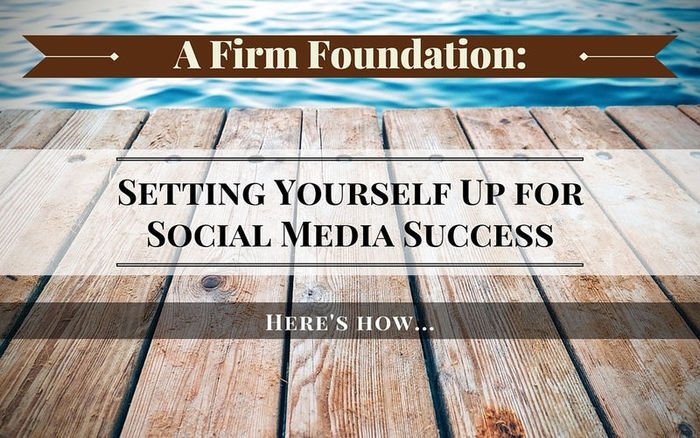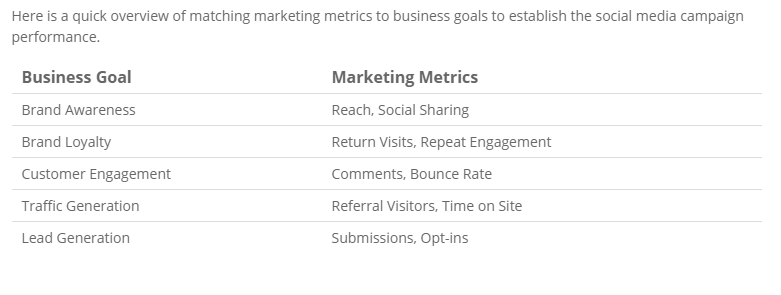This guide seeks to provide everything you’ll need to use social media for business. By the end, you’ll have learned how to choose the best social media network for YOUR company, between Linkedin, Twitter, Facebook, and Google Plus.
From social network demographics, best times to post, most shared content for each network, how and where to find great content to post, increasing engagement with your content, this is the proven plan we follow at Excellent Presence to build and grow our clients’ social accounts.
We hope it proves as useful for you as it has for us.
Using Social Media for Business: A Primer
Social media marketing can be great to help many types of companies more leads and clients from the Internet. [inlinetweet prefix=”” tweeter=”PrezNC” suffix=””]Common myth? That a windfall of clients will directly and immediately result from social media.[/inlinetweet] Measuring effectiveness of social media is not often that black and white.
Compare social media to TV advertising.
An effective TV commercial can surely generate leads the first time they see your commercial. But for most people? We need to experience your ad numerous times first, before we ever make a move to call, write, or visit your business.
Like television advertising does over time, social media marketing also helps your company build awareness and familiarity with your audience, subconsciously increasing the trust they have in your business (when done correctly!).
Save yourself some frustration: Remember, most of the benefit you’ll get from social media will not be direct nor immediate. You’ll be saved from making snap judgments later about whether your social media strategy is “working”!

Patience, young grasshopper.
Strategic use of social media can help build a community that loves hearing what your firm has to say, that will advocate for your brand, which can help you become a trusted, well-recognized industry name. Writing and posting relevant content to your social networks helps solidify your expertise in the eyes of your market.
Creating an Organized Social Media “Plan” (and Why NOT Having One Kills Results)
As with any marketing, the absolute worst thing to do is to go at social media marketing all willy-nilly—joining any network that tickles your fancy, firing off posts at random times in random spurts, and having no strategy ready to sustain things once you start.
Lacking structure would also make it seem as though you lack competence in your field.
Good thing your company isn’t handling things that way!
So let’s start by deciding just why you’ve chosen to use social media in the first place.

Step 1: Pre-Planning, Preparation, & FOCUS.
Before ANYTHING else, you’ll want to:
- define some up-to-date, concrete business goals for this stage of your growth;
- hone in on your industry, target audience;
- identify your true starting point; and
- review your business mission. (Yes, your mission!)
Going as deep as this may seem extraneous, but this “intro” stage is crucial. Answering the pointed questions below will help reconnect you with your passion, and your market… which will help indirectly get you mulling over your overall business goals.
You’ll then translate those later into social media goals.
Relax, it’ll be fun!
I’ll even plug in our company’s own answers for a real-world example of how to fill these out.
Question: Do you have high-level contacts to help fuel initial momentum?
Answer:
We had one high-level connection when conceptualizing our social media marketing strategy… but I wanted to reserve our “free ask” for more difficult pursuits. They didn’t help with initial momentum.
Question: Why did you start this business? What passion fuels it?
Answer:
I established this company to increase market utilization and representation of businesses by people of color and women. The social injustices borne by these groups perpetually fuel my company’s desire to help level the playing field and eliminate the need for government sectors like the NC Office for Historically Underutilized Businesses.
Businesses owned by people of color, specifically, are often under-rated and under-used while, strangely, being held to a higher standard. We exist to help these businesses reinvest money within their own communities to build a strong, self-sustaining, profitable economy—which will also help cultivate strong families and reduce class-based injustices.
Question: What is your company’s current biggest focus or challenge?
(Is it to get clients/leads? To increase brand awareness? To find sponsors/volunteers? To get newsletter subscribers to power a future promotion? Etc.)
This will be your underlying objective for every social media action—every blog post you lead people back to, every resource you share, every contact you make, etc. And not in a barbaric, “salesy” way, but in a long-term, directional way, to influence the types of relationships you build and the content you post.
Answer:
To find highly targeted clientele and grow the company at a fast enough rate, while still running lean without spreading ourselves too thinly.
Question: Where do the above “results” currently come from?
(“Results” refers to clients, followers, or whatever focus you identified in your previous answer.)
Whatever is currently working best to achieve those results, you may want to further concentrate your efforts on those same types of people, and on getting your message out in those same locations.
Answer:
What’s currently working best is direct outreach to our ideal clientele, being guided by the detailed user personas we created on our target market.
What’s also working well is sharing content to the exact places our ideal clientele frequents online.
Question: Who are your organization’s top competitors (up to 3)? Why?
Don’t reinvent the wheel. Pattern your promotions after what’s already working for others in your industry if you’re sure that it’s working. This also helps generate new ideas or new marketing venues you hadn’t thought of.
These 1 to 3 companies may dominate the space within which your company would like a share, OR they may simply be successful industry organizations with qualities you’d most like to emulate. These may not always be the most visible companies in your industry.
Answer:
We can’t release specifics here, but we chose these three companies for three different reasons.
Company 1 is doing fairly well on one of our top choice social networks, and has many of the same types of clients we plan to target. They’re quite active in their local community, with volunteerism, cool events, lectures, and even parties. Finally, they’re dominating Google. Company 1 has much more manpower and has been around for a lot longer, so while there’s a lot we can learn from this company, building that strong a presence will take considerable work.
Company 2 is a little company that appears to be run by a solopreneur. They’re doing well on Google, but don’t have a very strong brand, Web profile, or social presence. We can learn a lot about how they’ve done SEO, even without a social presence, to help us achieve similar results.
Company 3 is an industry giant, having done websites for prominent corporations. In turn, they have a large team… housed in a large building in our community. Although they’re powerhouses and target large businesses, there’s a lot we can learn from them in presentation, style, SEO domination, and brand. They don’t have a strong presence on social either, which again opens the door for us to lead in that regard.
Question: Describe your target audience.
It’s not enough to have a vague idea of who you’re targeting. Vague targets mean no real results.
Consider things like age, ethnicity, gender, occupation, level of volunteerism, salary range, marital status, # of children, geographic location, personality type, etc. Refer to your company’s buyer personas. If you don’t have any (…!), here are two guides to create some for a nonprofit or for-profit organization.
Answer:
Our audience is about equally M/F and multicultural, though mostly African American, Latino, or Caucasian. They’re family-oriented, are advocates for social justice and/or diversity, and make between $## and $## per year. They live in the South, and are positive, focused, strong-willed realists, passionate about making a difference with their work and their hobbies.
They range from seasoned business owners to being brand new to their industry. Their services and products are generally meaningful, and user experience is authentically important to them. They’re respectful and kind, not flashy but fairly sophisticated, and are often straightforward.
Respectful and kind, our market values building authentic personal connections with the businesses they frequent. Finally, they appreciate thoroughness, high expertise, and quality. They’re serious about their image, desiring a trustworthy, modern appearance to attract more clients/customers to make a bigger impact.
Question: What does your audience search for when seeking a company like yours?
Established companies will have some idea about this from client feedback. Nascent companies can start by looking again at your list of top competitors to see what they do and how the audience responds (both outwardly, with comments, but more subtly, with number of shares, etc.).
Knowing your market’s preferences and turn-offs helps you constantly “self-check” to ensure your social media image remains one they find appealing and trustworthy.
It also helps you speak in a language and tone they understand, appreciate, and gravitate toward.
Answer:
They seek a personal, comfortable experience, professional interactions, but with flexibility over rigidity and excess structure. High expertise and authentic concern for the welfare of their business. Attentiveness to their needs. Seeking trustworthiness, and an intimate, “small business” feel, they hate when an interaction feels scripted and can see through “over selling.”
Question: What single, SECONDARY goal do you expect from social media?
i.e., To get social media followers/fans, to collect emails, to increase market share, to add subscribers, etc. The secondary action is what you want people to do who don’t take your desired primary action right away.
Social media is a long-term strategy. You won’t often achieve your primary goal immediately.
(Some businesses won’t achieve it at all, due to taking shortcuts, following the “me too” train, and/or not understanding what they’re doing.)
So understand that your secondary goal can be just as important as your first. If done correctly, social media will be helping you… even when it seems it’s not making any impact.
So stick with it and accept that returns may not be immediate… but they are happening.
Answer:
To help cultivate search engine rankings to increase traffic to our website in order to increase awareness for our company and build market share.
All Done!
Perfect! Because you’ve taken the time to look deep into the heart of your organization and its marketing goals, it will be so much simpler to craft a focused, effective social media strategy for your company in the following stages. (Don’t you feel more focused already?)

Step 2: Decide How You’ll Gauge Social Media “Success.”
Once you start your social media campaign, whether handling it in-house or outsourcing, how will you know whether “it’s working”? How will you know whether to be satisfied or expect more?
A common (and costly) mistake by companies new to Internet marketing is to assume “success” with social media is measured by number of followers, likes, fans, etc.
While we suppose this could conceivably be a good measure if you’re building your account solely for show, these superficial metrics just won’t work for the majority of businesses.
So, if not numbers, what should you focus on as a measure of success? This chart from marketer Stuart J. Davidson helps us think about our business goals more specifically:

However, most small businesses can’t afford to spend time (or money) chasing “awareness, loyalty, and engagement” without specifically connecting those to DOLLARS.
Instead, we must focus on traffic generation and lead generation.
In fact, each “Business Goal” in the chart is really just an avenue toward our “ending” goal of increased profit. And depending on your business, you might achieve “profit” through the acquisition of clients/customers, volunteers, donations, sponsors, or repeat sales.
THAT is the goal we need to focus on.
Sure, we need social media to drive traffic.
And we hope to have high engagement, long website visit times, and brand loyalty.
But understand that all of these are a means to an end.
These metrics must result in tangible leads—contact or quote form submissions, list opt-ins, etc.—which, in turn, translate into transactions!
You’ll know your efforts are paying off when:
(1) many leads come from social media, and
(2) they also convert — rather than draining your team’s time, energy, & resources, but never buying anything (nor referring others).
Other less tangible (but no less valuable) benefits you might begin to see from social media marketing include:
- Increases in your website’s search rankings, especially for your most shared pages.
- Increased ease of getting clients and partners, due to better recognition in your industry.
- More members of your target audience mentioning that they’d heard of you before.
A) How will you track social media marketing results?
Many companies try to guesstimate whether they notice more sales per quarter, per year, etc. than before their social media campaign started.
Unless social media is the absolute ONLY marketing strategy you’re using, guesstimating will waste your time and money.
To know if your social media marketing is working, at minimum, you need to know WHICH NETWORK(S) the most leads are coming from, and how well they’re CONVERTING.
To track your social media leads, you’ll need:
(1) A good website stats tracker, to uncover how leads are finding you. (We use Piwik, not Google Analytics.)
(2) A good CRM, to store, organize, and keep track of where leads are in the sales process. (We use Streak.)
With these tools, you can also see how much better or worse leads are converting compared to other referral sources.
Getting More Specific: Calculating Your Social Media ROI
Knowing which networks you’re getting the most and best-converting leads from is a great start. But if you’re further along in the process of using social for business (i.e., revising your current social media plan instead of starting from scratch), it may be time to get more specific.
Neil Patel of Quick Sprout put together a great infographic showing how to calculate the monetary value of your social media leads. Instead of re-explaining, we’ll just include it for you below:

B) How much engagement should you expect from social media?
There is no easy answer to this question. It depends on your industry, number of followers, posting frequency, average engagement for your industry, whether you’re posting when your audience is online… and much more.
Our research over the years consistently shows that posting very frequently does not necessarily equate to a super-engaged social following. (Of course.)
If it did, then why wouldn’t all companies blasting out tweets, posts, or articles numerous times per day have social engagement through the roof?
Factors that do influence the amount of engagement you’ll receive include:
- how well you target your followers (much of what this guide is for);
- how closely your content aligns with what they find interesting or newsworthy;
- frequency of posting, to some degree (i.e., not constantly, but also not rarely);
- how many people your followers follow (is their timeline too busy?);
- your industry (is it over-saturated and harder to cut through the noise?);
- and a melee of other factors we’ll dive into later in the guide.
“The perfect formula” for maximizing social media engagement is unique to your specific organization. This guide was created to help you find it. ツ
Up next, we’ll look at 149 important social media statistics to help choose the best network for YOUR business.

